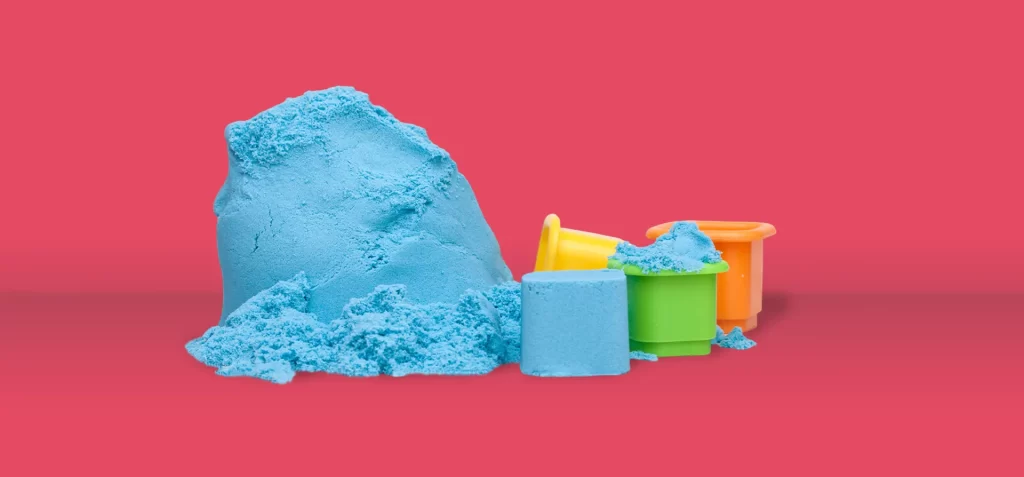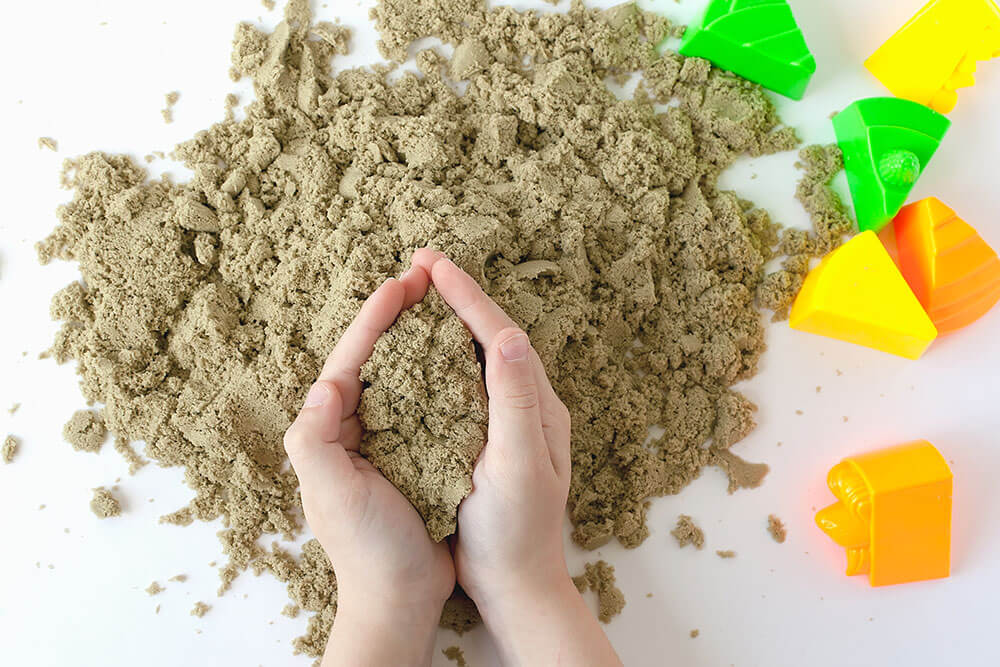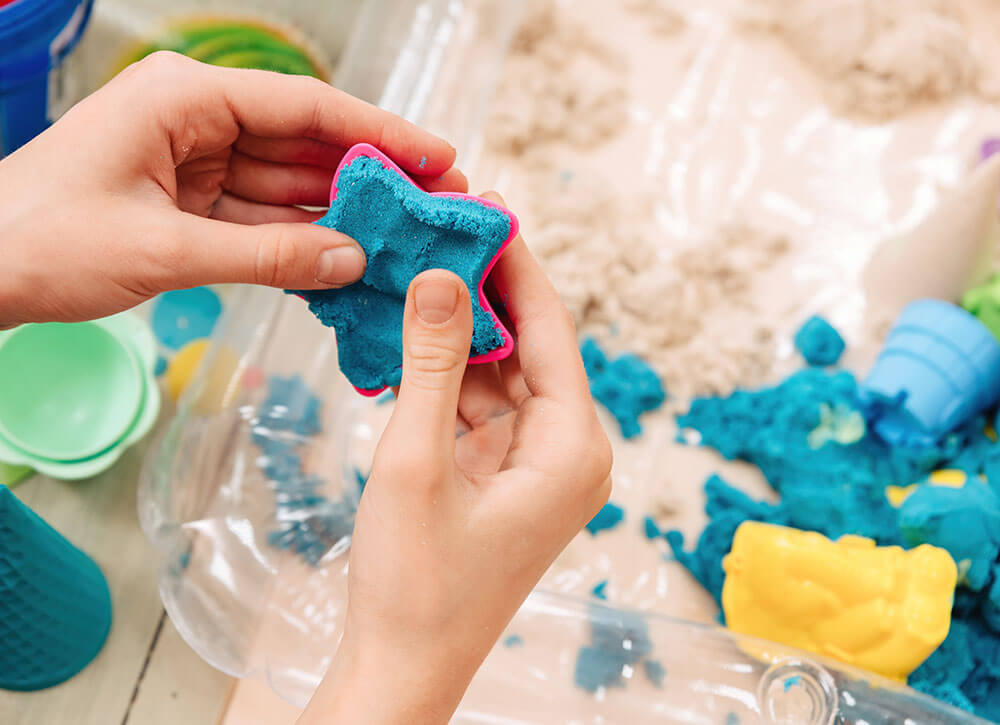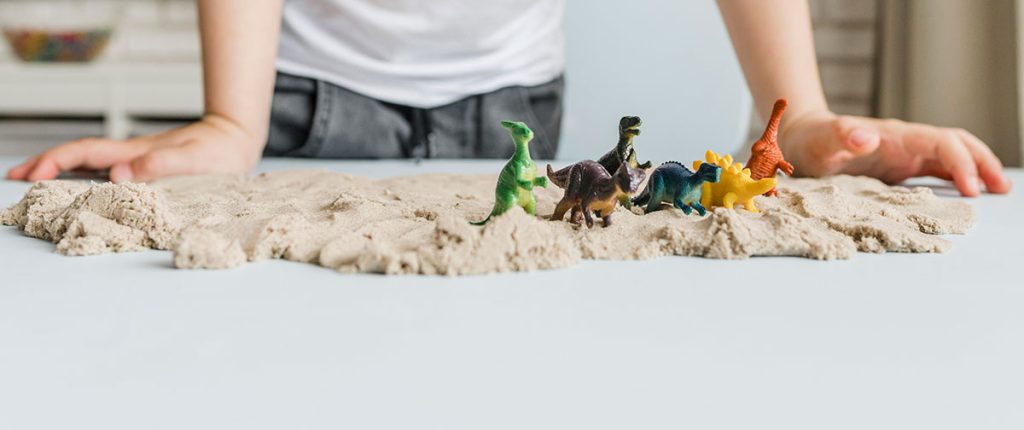
When you think of magic sand or kinetic sand, most likely you would think of childrens toys and a fun material to use in science experiments. But magic sand actually has a lot of real world applications that you may not know about. In this article, we will get a better understanding of magic and kinetic sand and what applications they may have. Towards the end we will also answer some common questions people may have about both magic sand and kinetic sand.
When learning anything, it’s better to start at the basics. So, What is Magic Sand?
Magic sand, also known as hydrophobic sand, is regular sand that has been sprayed with a coat of a water-repellent material, such as silicone or wax. This coating causes the new magic sand to behave in some fascinating ways including its ability to repel water.
When dry, magic sand appears and feels like regular sand. However, when it comes into contact with water, it becomes hydrophobic, and the water is repelled, causing the sand to remain dry. This unique property of magic sand allows it to be used in a variety of fun and educational applications.

Now that you have a brief understanding of magic sand, let’s get into a more specific and detailed explanation of Magic Sand and how it works.
Like I mentioned earlier, magic sand is also known as hydrophobic sand. If you don’t know what hydrophobic is, then let me explain. The hydrophobic coating on magic sand repels water molecules, causing the sand to remain dry even when submerged in water. This is because the coating creates a barrier between the sand and the water, preventing the sand grains from coming into contact with water molecules. As a result, magic sand can be molded and shaped underwater without becoming wet or losing its form.
Now if you aren’t sure what a hydrophobic coating is, then let’s talk about it. A hydrophobic coating is a thin layer of material that repels water. Hydrophobic coatings are made up of molecules that have a low surface energy and are therefore not attracted to water molecules. When a surface is coated with a hydrophobic material, it becomes water-repellent, meaning that water beads up and rolls off the surface instead of being absorbed or sticking to it.

Now if you’re wondering “is magic sand the same as kinetic sand,” then the answer is yes but no. You see, kinetic sand is very similar to magic sand but they both have their own differences in their properties. Let’s start with getting a brief introduction to kinetic sand.

Kinetic sand is also just regular sand that has been coated with a special polymer that makes it act like a solid when it is molded or shaped, but also allows it to flow like a liquid when it is poured. It was first introduced in 2009 by a Swedish company named Waba Fun, and has since become a popular toy for children and adults alike. Kinetic sand is often used in sensory play activities, as it provides a unique tactile experience and can be molded into various different shapes as well as structures. It is also non-toxic, easy to clean up, and can be reused multiple times.
Now it could be confusing because that whole explanation about kinetic sand sounds very similar if not the same to magic sand. So let’s dive into the key differences in magic sand and kinetic sand.
Like I said earlier, kinetic and magic sand are similar but different. At face value they are the same. But when diving into what makes up magic sand and kinetic sand, we can see the differences. Magic sand and kinetic sand are both just regular sand that’s been treated with special coatings to give them unique properties.
However, there are some key differences between magic and kinetic sand:
1. Coating
Magic sand is typically coated with a hydrophobic substance, such as silicone or wax, which repels water and makes the sand waterproof. Kinetic sand however, is coated with a polymer that allows it to flow like a liquid but also stick to itself like a solid.
2. Texture
Magic sand can feel slightly grainy or rough to the touch, while kinetic sand has a smoother texture.
3. Playability
Magic sand is often used in water-based activities, such as building sandcastles that can be submerged in water, while kinetic sand is more commonly used for sensory play and molding into various different shapes and structures.

4. Cleanup
Magic sand can be more difficult to clean up than kinetic sand, as it can clump together and stick to surfaces when wet. Kinetic sand is generally easier to clean up, as it can be molded back into a cohesive shape and picked up with a scoop or spatula.
Overall, magic sand and kinetic sand both provide unique sensory experiences and can be used for creative play, but their properties and uses differ slightly.
Kinetic sand, like magic sand, is a special type of sand that is designed to stick to itself, allowing it to be easily molded and shaped without the need for water or other bonding agents. Kinetic sand is usually made of 98% sand and 2% polydimethylsiloxane (PDMS), a type of silicone oil.
While kinetic sand can dry out over time, it generally takes a long time for this to happen. Because of the PDMS in the sand, the sand is resistant to drying out and will remain pliable for a longer period than regular sand. However, if left exposed to the air for extended periods, the sand may begin to dry out and lose its kinetic properties.

Both Magic Sand and Kinetic Sand are very versatile materials that can be used for various purposes.
Here are some of the most common uses of magic sand:
a. Children’s Toys
You most likely already knew this but, Magic sand is often used in children’s toys as it allows kids to build structures and shapes that don’t collapse when they’re wet. It’s a fun and educational way to explore concepts like water displacement, buoyancy, and erosion.

b. Science Experiments
You might’ve encountered magic or kinetic sand at school once during one of your science classes as magic sand is a popular material used in science experiments to demonstrate how hydrophobic materials work. It’s a popular choice for experiments that focus on water-repelling properties, such as creating water-resistant materials or studying the properties of soil.
c. Construction
This might come as a surprise but Magic sand can be used in construction to create water-resistant materials. It’s particularly useful in areas where water damage is a common problem, such as around swimming pools, ponds, and other water features.
d. Oil Spills
If you’ve ever watched a race or been to a race track, you might’ve seen people spilling sand onto the track after a crash or accident. This is because magic sand is used in oil spills to absorb oil while repelling water. This makes cleanup easier and less damaging to the environment.
e. Art and Crafts
Now last but not least, Magic sand can be used in art and crafts projects to create unique textures and effects. It can be mixed with paint or glue to create interesting textures and patterns.

Like we mentioned earlier, magic sand has water repelling properties. Although, It is important to note that while magic sand is resistant to getting wet, it is not completely waterproof. Over time, the water-repelling coating on the sand particles can wear off, which may cause the sand to lose its hydrophobic properties and become more susceptible to getting wet. Additionally, if the sand is placed in water for an extended period, it may eventually become saturated and lose its ability to repel water
When magic sand gets wet, the sand particles become temporarily wet and clump together. However, because of the water-repelling coating on the particles of the sand, the sand remains dry at the core, forming a barrier that prevents the water from fully saturating the sand.
As a result, when the sand is wet it may take on a slightly darker appearance, and it may become temporarily more malleable or clump together. However, as the water evaporates, the sand will eventually go back to its original, dry, and hydrophobic state.
In conclusion, magic and kinetic sand is a fun and useful material for both in the work field and at home! I hope in this article you learned a deeper understanding of magic sand and the key differences between the two.
If you are looking to buy kinetic sand in bulk for your business or personal needs, magicsandfactory are leading the wholesale market for magic sand! They offer a variety of different colors all in bulk! Start your journey with magic sand with magicsandfactory!
For any questions or quotes about our Sensory Sands!